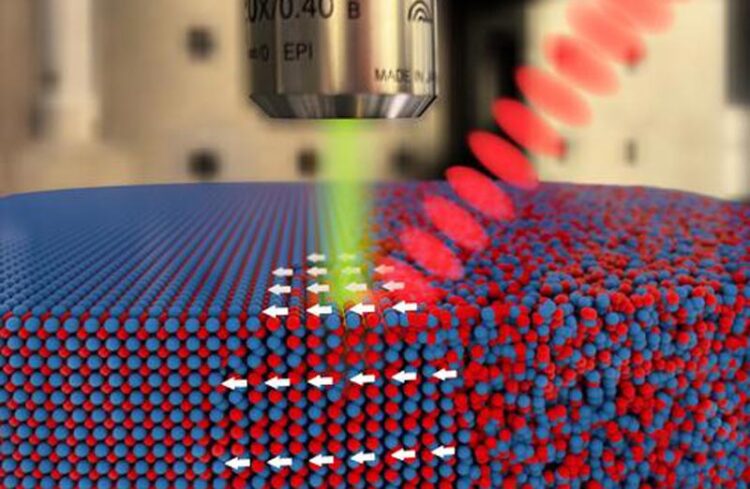Magnetization by laser pulse

If a strong laser pulse hits an iron alloy, the material melts briefly at the irradiated point and a tiny magnetic area forms.
Credit: HZDR / Sander Münster
Research team identifies new details of a promising phenomenon.
To magnetize an iron nail, one simply has to stroke its surface several times with a bar magnet. Yet, there is a much more unusual method: A team led by the Helmholtz-Zentrum Dresden-Rossendorf (HZDR) discovered some time ago that a certain iron alloy can be magnetized with ultrashort laser pulses. The researchers have now teamed up with the Laserinstitut Hochschule Mittweida (LHM) to investigate this process further. They discovered that the phenomenon also occurs with a different class of materials – which significantly broadens potential application prospects. The working group presents its findings in the scientific journal Advanced Functional Materials (DOI: 10.1002/adfm.202311951).
The unexpected discovery was made back in 2018. When the HZDR team irradiated a thin layer of an iron-aluminum alloy with ultrashort laser pulses, the non-magnetic material suddenly became magnetic. The explanation: The laser pulses rearrange the atoms in the crystal in such a way that the iron atoms move closer together, and thus forming a magnet. The researchers were then able to demagnetize the layer again with a series of weaker laser pulses. This enabled them to discover a way of creating and erasing tiny “magnetic spots” on a surface.
However, the pilot experiment still left some questions unanswered. “It was unclear whether the effect only occurs in the iron-aluminum alloy or also in other materials,” explains HZDR physicist Dr. Rantej Bali. “We also wanted to try tracking the time progression of the process.” For further investigation, he teamed up with Dr. Theo Pflug from the LHM and colleagues from the University of Zaragoza in Spain.
Flip book with laser pulses
The experts focused specifically on an iron-vanadium alloy. Unlike the iron-aluminum alloy with its regular crystal lattice, the atoms in the iron-vanadium alloy are arranged more chaotically, forming an amorphous, glass-like structure. In order to observe what happens upon laser irradiation, the physicists used a special method: The pump-probe method.
“First, we irradiate the alloy with a strong laser pulse, which magnetizes the material,” explains Theo Pflug. “Simultaneously, we use a second, weaker pulse that is reflected on the material surface.”
The analysis of the reflected laser pulse provides an indication of the material’s physical properties. This process is repeated several times, whereby the time interval between the first “pump” pulse and the subsequent “probe” pulse is continually extended.
As a result, a time series of reflection data is obtained, which allows to characterize the processes being triggered by the laser excitation. “The whole procedure is similar to generating a flip book,” says Pflug. “Likewise, a series of individual images that animate when viewed in quick succession.”
Rapid melting
The result: Although it has a different atomic structure than the iron-aluminum compound, the iron-vanadium alloy can also be magnetized via laser. “In both cases, the material melts briefly at the irradiation point”, explains Rantej Bali. “This causes the laser to erase the previous structure so that a small magnetic area is generated in both alloys.”
An encouraging result: Apparently, the phenomenon is not limited to a specific material structure but can be observed in diverse atomic arrangements.
The team is also keeping track of the temporal dynamics of the process: “At least we now know in which time scales something happens,” explains Theo Pflug. “Within femtoseconds, the laser pulse excites the electrons in the material. Several picoseconds later, the excited electrons transfer their energy to the atomic nuclei.”
Consequently, this energy transfer causes the rearrangement into a magnetic structure, which is stabilized by the subsequent rapid cooling. In follow-up experiments, the researchers aim to observe exactly how the atoms rearrange themselves by examining the magnetization process with intense X-rays.
Sights set on applications
Although still in the early stages, this work already provides initial ideas for possible applications: For example, placing tiny magnets on a chip surface via laser is conceivable. “This could be useful for the production of sensitive magnetic sensors, such as those used in vehicles,” speculates Rantej Bali. “It could also find possible applications in magnetic data storage.”
Additionally, the phenomenon appears relevant for a new type of electronics, namely spintronics. Here, magnetic signals should be used for digital computing processes instead of electrons passing through transistors as usual – offering a possible approach to computer technology of the future.
Journal: Advanced Functional Materials
DOI: 10.1002/adfm.202311951
Method of Research: Experimental study
Subject of Research: Not applicable
Article Title: Laser-Induced Positional and Chemical Lattice Reordering Generating Ferromagnetism
Article Publication Date: 21-Nov-2023
Media Contact
All latest news from the category: Materials Sciences
Materials management deals with the research, development, manufacturing and processing of raw and industrial materials. Key aspects here are biological and medical issues, which play an increasingly important role in this field.
innovations-report offers in-depth articles related to the development and application of materials and the structure and properties of new materials.
Newest articles
Faster, more energy-efficient way to manufacture an industrially important chemical
Zirconium combined with silicon nitride enhances the conversion of propane — present in natural gas — needed to create in-demand plastic, polypropylene. Polypropylene is a common type of plastic found…

Energy planning in Ghana as a role model for the world
Improving the resilience of energy systems in the Global South. What criteria should we use to better plan for resilient energy systems? How do socio-economic, technical and climate change related…

Artificial blood vessels could improve heart bypass outcomes
Artificial blood vessels could improve heart bypass outcomes. 3D-printed blood vessels, which closely mimic the properties of human veins, could transform the treatment of cardiovascular diseases. Strong, flexible, gel-like tubes…





















